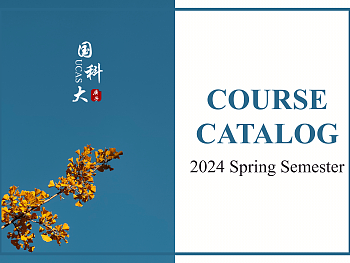by admin
-
Jan 22, 2024
NumCodeNameTypeHours/CreditsCapacityWeeksDatesClassroomFirst Class DateAssistant Teacher11801010703I0P1003YNanotechnology for Solar Energy UtilizationProfessional Course50/2.5802nd-16thWed.(5-7)Teaching building5052023/3/6gongy2019@nanoctr.cn21801010703I0P1004YNano Electronic MaterialsProfessional Course52/2.5585th-16thThu.(5-7)Teaching building3042023/3/28wujuanxia@nanoctr.cn31801010703I0P1005YDNA NanobiotechnologyProfessional Course40/2.0402nd-15thWed.(5-7)Teaching building4212023/3/6liunan232@mails.ucas.ac.cn41801010705I0P1001YPhysical GeographyProfessional Course60/3.0582nd-16thTue.(5-7)Teaching building2122023/3/5kangjian@itpcas.ac.cn51801010705I0P1003YApplications of Remote Sensing on Climate Change, Land Science and Severe WeatherProfessional Course60/3.0582nd-16thFri.(9-11)Teaching building2042023/3/8lidh@igsnrr.ac.cn61801010705I0P1004YDevelopment GeographyProfessional Course60/3.0242nd-16thTue.(5-7)Teaching building4062023/3/5wangwx.20b@igsnrr.ac.cn71801010705I0P1011YApplications of Data Analysis Methods in Earth SciencesProfessional Course40/2.01702nd-16thWed.(5-7)Teaching building阶二52023/3/6shijiali4523@igsnrr.ac.cn81801010705I0P1012YRemote sensing cloud computing and scientific analysisProfessional Course50/2.5402nd-10thTue.(9-11);Thu.(9-11)Teaching building6112023/3/5wangtiantian3535@igsnrr.ac.cn91801010705I0P2001YGeospatial Processing With PythonProfessional Course50/2.5402nd-12thTue.(5-7);Thu.(5-7)Teaching building5112023/3/5heyan211@mails.ucas.ac.cn101801010705I0P2002YThermal infrared remote sensingProfessional Course40/2.0402nd-15thMon.(2-4)Teaching building4052023/3/4chengyuanliang7252@igsnrr.ac.cn111801010706I0P1002YClimate ChangeProfessional Course64/3.0582nd-16thMon.(2-4)Teaching building5052023/3/4wqma@itpcas.ac.cn121801010709I0P1001YPlate Tectonics and Evolution of Tibetan PlateauProfessional Course75/4.0402nd-16thWed.(5-7);Fri.(5-7)Teaching building5112023/3/6flcai@itpcas.ac.cn131801010710I0P1005YNano-biologyProfessional Course50/2.5402nd-14thMon.(9-10);Thu.(9-10)Teaching building4212023/3/4lantongchun21@mails.ucas.ac.cn141801010710I0P1007YMolecular Entomology and Plant PathologyProfessional Course51/2.5402nd-18thTue.(5-7)Teaching building4132023/3/5jiangh@ioz.ac.cn151801010710I0P1008YBiochemistryProfessional Course60/3.0402nd-16thTue.2-4);Thu.(2-4)(Only in weeks 2-6)Humanities Building教一12023/3/5tanjingjing22@mails.ucas.ac.cn161801010710I0P1009YConservation BiologyProfessional Course60/3.0402nd-16thFri.(5-7)Teaching building6112023/3/8xuecongliu@ucas.ac.cn171801010710I0P1010YIntroduction to Epigenetics and RNA SilencingProfessional Course60/3.0582nd-16thThu.(5-7)Teaching building2112023/3/7liqi@ioz.ac.cn181801010710I0P1011YNanobiological Sensing and DetectionProfessional Course60/3.0402nd-11thTue.(5-7);Thu.(2-4)Teaching building6112023/3/5yixl2021@nanoctr.cn191801010710I0P1013YIntegrative Systematic BiologyProfessional Course51/2.5902nd-16thThu.(5-7)Teaching building阶一22023/3/7zhouqingsong@ioz.ac.cn201801010713I0P1001YGlobal Change EcologyProfessional Course60/3.0802nd-16thWed.(5-7)Teaching building阶一6.2023/3/6yutongzhao@itpcas.ac.cn211801010713I0P1002YPlant Physiology and EcologyProfessional Course51/2.5802nd-16thFri.(5-7)Teaching building阶一2;2023/3/8mftang@rcees.ac.cn221801010714I0P1002YApplied StatisticsProfessional Course50/2.5802nd-16thMon.(5-7);Fri.(5-7)(Only in weeks 2-6)Teaching building505;Teaching building阶一12023/3/4zhusihan21@mails.ucas.ac.cn231801010812I0P1004YFundamental for Internet of Things and Its Applications Professional Course50/2.5582nd-16thMon.(9-11)Teaching building2112023/3/4liyue22@csu.ac.cn241801010812I0P1006YComputer vision and Machine LearningProfessional Course40/2.0403rd-16thWed.(9-11)Teaching building2142023/3/11zhaoyanchao22@mails.ucas.ac.cn251801010817I0P1001YChemical Reaction EngineeringProfessional Course60/3.0802nd-16thThu.(9-11)Teaching building5052023/3/7yxia@ipe.ac.cn261801010817I0P1002YGreen Chemical EngineeringProfessional Course60/3.0582nd-16thWed.(5-7)Teaching building6042023/3/6wangrunzhi22@mails.ucas.ac.cn271801010817I0P1003YEnergy Chemistry and chemical engineeringProfessional Course60/3.0402nd-16thMon.(5-7);Fri.(5-7)(Only in weeks 11-16)Teaching building405;Teaching building2142023/3/4suting231@mails.ucas.ac.cn281801010817I0P1004YFluidization Engineering and Multiphase FlowProfessional Course60/3.0402nd-16thWed.(2-4)Teaching building6112023/3/6wxr770406@163.com291801010830I0P1008YAnalytical Chemistry and Measurement ApplicationProfessional Course50/2.5402nd-16thThu.(9-11)Teaching building阶二32023/3/715850782626@163.com30180101050211PX004YSkills in Making Academic Presentations in EnglishOptional courses40/1.0582nd-14thThu.(5-7)Teaching building 4122024/3/7shenyuling22@mails.ucas.ac.cn31180101050211PX001YAcademic Communication for International ConferencesOptional courses40/1.0402nd-14thMon.(5-7)Teaching building 6202024/3/4zhouyingkun15@mails.ucas.ac.cn32180101050102PB003Y-01China PanoramaPublic compulsory courses48/2.0802nd-18thWed.(9-11)Teaching building 3052024/3/6wqq000816@163.com33180101120500PB003YAcademic Morality and Writing NormsPublic compulsory courses20/1.0803th-9thMon.(9-11)Teaching building 3052024/3/11fanrong22@mails.ucas.ac.cn34180101050102PB001Y-01Elementary Chinese1Public compulsory courses128/2.0402nd-18thMon.(1-4) Thu.(1-4);Teaching building 304 Teaching building 6042024/3/4luowei_official@163.com35180101050102PB002Y-01Elementary Chinese2Public compulsory courses128/2.0402nd-18thTue.1-4; Fri.1-4Teaching building 304 Teaching building 5042024/3/4luowei_official@163.com36180101050211PX001Y-01Academic Communication for International ConferencesOptional courses40/1.0402nd-14thThu.(2-4)Teaching building 3202024/3/7zhouyingkun15@mails.ucas.ac.cnClick to download file:International College timetable 2024 Spring Semester.xlsx










